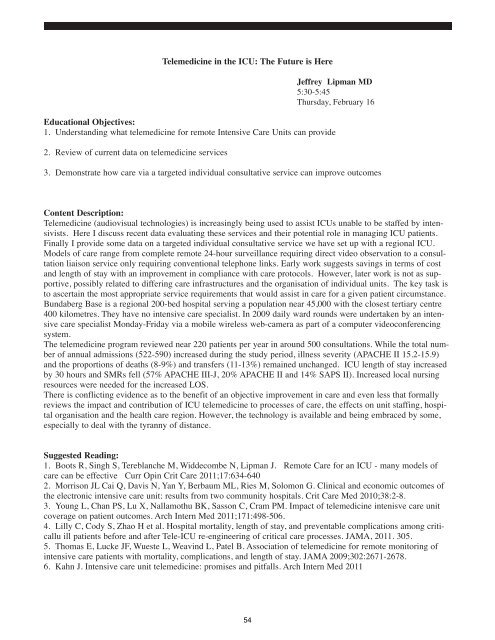ABSTRACTS from 16th International COnference on ... - CRRT Online
ABSTRACTS from 16th International COnference on ... - CRRT Online
ABSTRACTS from 16th International COnference on ... - CRRT Online
Create successful ePaper yourself
Turn your PDF publications into a flip-book with our unique Google optimized e-Paper software.
Telemedicine in the ICU: The Future is Here<br />
Jeffrey Lipman MD<br />
5:30-5:45<br />
Thursday, February 16<br />
Educati<strong>on</strong>al Objectives:<br />
1. Understanding what telemedicine for remote Intensive Care Units can provide<br />
2. Review of current data <strong>on</strong> telemedicine services<br />
3. Dem<strong>on</strong>strate how care via a targeted individual c<strong>on</strong>sultative service can improve outcomes<br />
C<strong>on</strong>tent Descripti<strong>on</strong>:<br />
Telemedicine (audiovisual technologies) is increasingly being used to assist ICUs unable to be staffed by intensivists.<br />
Here I discuss recent data evaluating these services and their potential role in managing ICU patients.<br />
Finally I provide some data <strong>on</strong> a targeted individual c<strong>on</strong>sultative service we have set up with a regi<strong>on</strong>al ICU.<br />
Models of care range <str<strong>on</strong>g>from</str<strong>on</strong>g> complete remote 24-hour surveillance requiring direct video observati<strong>on</strong> to a c<strong>on</strong>sultati<strong>on</strong><br />
liais<strong>on</strong> service <strong>on</strong>ly requiring c<strong>on</strong>venti<strong>on</strong>al teleph<strong>on</strong>e links. Early work suggests savings in terms of cost<br />
and length of stay with an improvement in compliance with care protocols. However, later work is not as supportive,<br />
possibly related to differing care infrastructures and the organisati<strong>on</strong> of individual units. The key task is<br />
to ascertain the most appropriate service requirements that would assist in care for a given patient circumstance.<br />
Bundaberg Base is a regi<strong>on</strong>al 200-bed hospital serving a populati<strong>on</strong> near 45,000 with the closest tertiary centre<br />
400 kilometres. They have no intensive care specialist. In 2009 daily ward rounds were undertaken by an intensive<br />
care specialist M<strong>on</strong>day-Friday via a mobile wireless web-camera as part of a computer videoc<strong>on</strong>ferencing<br />
system.<br />
The telemedicine program reviewed near 220 patients per year in around 500 c<strong>on</strong>sultati<strong>on</strong>s. While the total number<br />
of annual admissi<strong>on</strong>s (522-590) increased during the study period, illness severity (APACHE II 15.2-15.9)<br />
and the proporti<strong>on</strong>s of deaths (8-9%) and transfers (11-13%) remained unchanged. ICU length of stay increased<br />
by 30 hours and SMRs fell (57% APACHE III-J, 20% APACHE II and 14% SAPS II). Increased local nursing<br />
resources were needed for the increased LOS.<br />
There is c<strong>on</strong>flicting evidence as to the benefit of an objective improvement in care and even less that formally<br />
reviews the impact and c<strong>on</strong>tributi<strong>on</strong> of ICU telemedicine to processes of care, the effects <strong>on</strong> unit staffing, hospital<br />
organisati<strong>on</strong> and the health care regi<strong>on</strong>. However, the technology is available and being embraced by some,<br />
especially to deal with the tyranny of distance.<br />
Suggested Reading:<br />
1. Boots R, Singh S, Tereblanche M, Widdecombe N, Lipman J. Remote Care for an ICU - many models of<br />
care can be effective Curr Opin Crit Care 2011;17:634-640<br />
2. Morris<strong>on</strong> JL Cai Q, Davis N, Yan Y, Berbaum ML, Ries M, Solom<strong>on</strong> G. Clinical and ec<strong>on</strong>omic outcomes of<br />
the electr<strong>on</strong>ic intensive care unit: results <str<strong>on</strong>g>from</str<strong>on</strong>g> two community hospitals. Crit Care Med 2010;38:2-8.<br />
3. Young L, Chan PS, Lu X, Nallamothu BK, Sass<strong>on</strong> C, Cram PM. Impact of telemedicine intenisve care unit<br />
coverage <strong>on</strong> patient outcomes. Arch Intern Med 2011;171:498-506.<br />
4. Lilly C, Cody S, Zhao H et al. Hospital mortality, length of stay, and preventable complicati<strong>on</strong>s am<strong>on</strong>g criticallu<br />
ill patients before and after Tele-ICU re-engineering of critical care processes. JAMA, 2011. 305.<br />
5. Thomas E, Lucke JF, Wueste L, Weavind L, Patel B. Associati<strong>on</strong> of telemedicine for remote m<strong>on</strong>itoring of<br />
intensive care patients with mortality, complicati<strong>on</strong>s, and length of stay. JAMA 2009;302:2671-2678.<br />
6. Kahn J. Intensive care unit telemedicine: promises and pitfalls. Arch Intern Med 2011<br />
54
















